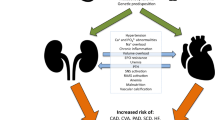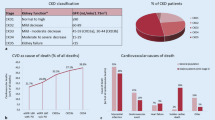Abstract
Chronic kidney disease (CKD) is associated with substantial cardiovascular morbidity and mortality. This is mediated by highly prevalent traditional cardiovascular risk factors such as arterial hypertension and diabetes mellitus in patients with CKD, but also by the presence of CKD-specific so-called nontraditional cardiovascular risk factors such as vascular calcification, uremic toxins, uremic dyslipidemia, inflammation, and oxidative stress. Therefore, the primary and secondary prevention of cardiovascular disease represents an important part of the care of patients with CKD. This entails optimal control of blood pressure and diabetes, treatment of the uremic dyslipidemia, as well as life-style modifying factors such as weight reduction and smoking cessation.
Zusammenfassung
Die chronische Nierenerkrankung ist mit einer erheblichen kardiovaskulären Morbidität und Mortalität assoziiert. Ursächlich hierfür ist zum einen die hohe Prävalenz traditioneller kardiovaskulärer Risikofaktoren wie arterielle Hypertonie und Diabetes mellitus bei Nierenkranken und zum anderen niereninsuffizienzspezifische, sog. nichttraditionelle kardiovaskuläre Risikofaktoren. Hierzu gehören vaskuläre Kalzifikation, Urämietoxine, die urämische Dyslipidämie sowie Inflammation und oxidativer Stress. Deshalb kommt der Primär- und Sekundärprävention kardiovaskulärer Erkrankungen in der Nephrologie eine zentrale Rolle zu. Hierzu gehören eine optimale Blutdruck- und Blutzuckereinstellung, die Therapie der urämischen Dyslipidämie sowie lebensstilmodifizierende Faktoren wie Gewichtsreduktion und Nikotinkarenz.


Similar content being viewed by others
References
Andrassy KM (2013) Comments on “KDIGO 2012 clinical practice guideline for the evaluation and management of chronic kidney disease”. Kidney Int 84(3):622–623
Gansevoort RT et al (2013) Chronic kidney disease and cardiovascular risk: epidemiology, mechanisms, and prevention. Lancet 382(9889):339–352
Saran R et al (2019) US renal data system 2018 annual data report: epidemiology of kidney disease in the United States. Am J Kidney Dis 73(3S1):A7–A8
Ortiz A et al (2014) Epidemiology, contributors to, and clinical trials of mortality risk in chronic kidney failure. Lancet 383(9931):1831–1843
Drueke TB, Massy ZA (2010) Atherosclerosis in CKD: differences from the general population. Nat Rev Nephrol 6(12):723–735
Speer T, Zewinger S, Fliser D (2013) Uraemic dyslipidaemia revisited: role of high-density lipoprotein. Nephrol Dial Transplant 28(10):2456–2463
Speer T et al (2013) Abnormal high-density lipoprotein induces endothelial dysfunction via activation of toll-like receptor‑2. Immunity 38(4):754–768
Speer T et al (2014) HDL cholesterol is not associated with lower mortality in patients with kidney dysfunction. J Am Soc Nephrol 25(5):1073–1082
Holy EW et al (2016) Carbamylated low-density lipoproteins induce a prothrombotic state via LOX-1: impact on arterial thrombus formation in vivo. J Am Coll Cardiol 68(15):1664–1676
Speer T et al (2014) Carbamylated low-density lipoprotein induces endothelial dysfunction. Eur Heart J 35(43):3021–3032
Zewinger S et al (2016) Innate immunity in CKD-associated vascular diseases. Nephrol Dial Transplant 31(11):1813–1821
Knauf F, Brewer JR, Flavell RA (2019) Immunity, microbiota and kidney disease. Nat Rev Nephrol 15(5):263–274
Ali S et al (2019) Primary and secondary prevention of cardiovascular disease in patients with chronic kidney disease. Curr Atheroscler Rep 21(9):32
Verbeke F et al (2014) A European renal best practice (ERBP) position statement on the kidney disease: improving global outcomes (KDIGO) clinical practice guideline for the management of blood pressure in non-dialysis-dependent chronic kidney disease: an endorsement with some caveats for real-life application. Nephrol Dial Transplant 29(3):490–496
SPRINT Research Group et al (2015) A randomized trial of intensive versus standard blood-pressure control. N Engl J Med 373(22):2103–2116
Cheung AK et al (2017) Effects of intensive BP control in CKD. J Am Soc Nephrol 28(9):2812–2823
ACCORD Study Group et al (2010) Effects of intensive blood-pressure control in type 2 diabetes mellitus. N Engl J Med 362(17):1575–1585
**e X et al (2016) Renin-angiotensin system inhibitors and kidney and cardiovascular outcomes in patients with CKD: a Bayesian network meta-analysis of randomized clinical trials. Am J Kidney Dis 67(5):728–741
Fried LF et al (2013) Combined angiotensin inhibition for the treatment of diabetic nephropathy. N Engl J Med 369(20):1892–1903
Tobe SW et al (2011) Cardiovascular and renal outcomes with telmisartan, ramipril, or both in people at high renal risk: results from the ONTARGET and TRANSCEND studies. Circulation 123(10):1098–1107
Tonelli M, Wanner C, Kidney Disease: Improving Global Outcomes Lipid Guideline Development Work Group Members (2014) Lipid management in chronic kidney disease: synopsis of the kidney disease: improving global outcomes 2013 clinical practice guideline. Ann Intern Med 160(3):182
Cholesterol Treatment Trialists’ (CTT) Collaboration et al (2016) Impact of renal function on the effects of LDL cholesterol lowering with statin-based regimens: a meta-analysis of individual participant data from 28 randomised trials. Lancet Diabetes Endocrinol 4(10):829–839
Kidney Disease: Improving Global Outcomes (KDIGO) Diabetes Work Group (2020) KDIGO 2020 clinical practice guideline for diabetes management in chronic kidney disease. Kidney Int 98(4S):S1–S115
Palmer SC et al (2012) Benefits and harms of statin therapy for persons with chronic kidney disease: a systematic review and meta-analysis. Ann Intern Med 157(4):263–275
SEARCH Collaborative Group et al (2008) SLCO1B1 variants and statin-induced myopathy—a genomewide study. N Engl J Med 359(8):789–799
Toth PP et al (2018) Efficacy and safety of lipid lowering by alirocumab in chronic kidney disease. Kidney Int 93(6):1397–1408
Charytan DM et al (2019) Efficacy and safety of evolocumab in chronic kidney disease in the FOURIER trial. J Am Coll Cardiol 73(23):2961–2970
Neal B et al (2017) Canagliflozin and cardiovascular and renal events in type 2 diabetes. N Engl J Med 377(7):644–657
Wanner C et al (2016) Empagliflozin and progression of kidney disease in type 2 diabetes. N Engl J Med 375(4):323–334
Heerspink HJL et al (2020) Dapagliflozin in patients with chronic kidney disease. N Engl J Med 383(15):1436–1446
Turin TC et al (2012) Chronic kidney disease and life expectancy. Nephrol Dial Transplant 27(8):3182–3186
Author information
Authors and Affiliations
Corresponding author
Ethics declarations
Conflict of interest
S.J. Schunk, T. Speer and D. Fliser declare that they have no competing interests.
For this article no studies with human participants or animals were performed by any of the authors. All studies performed were in accordance with the ethical standards indicated in each case.
Rights and permissions
About this article
Cite this article
Schunk, S.J., Speer, T. & Fliser, D. Heart and kidney disease: a cardiovascular high-risk constellation. Herz 46, 206–211 (2021). https://doi.org/10.1007/s00059-020-05012-z
Accepted:
Published:
Issue Date:
DOI: https://doi.org/10.1007/s00059-020-05012-z




